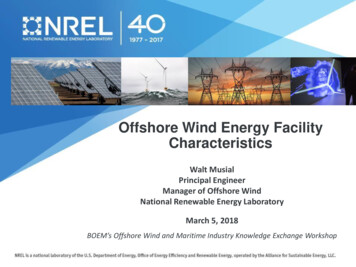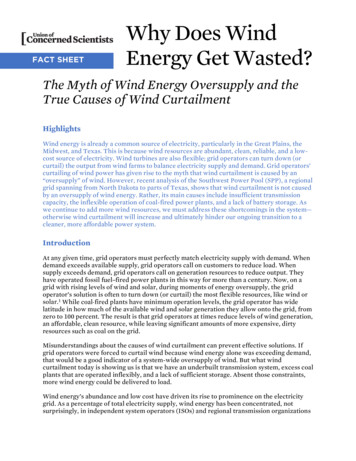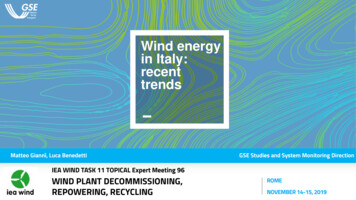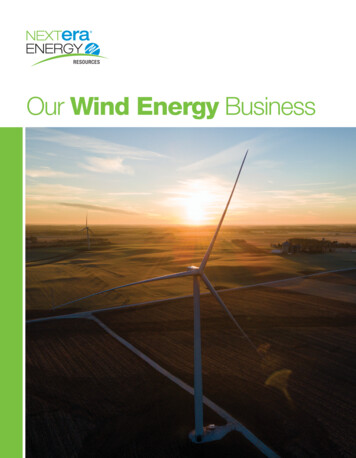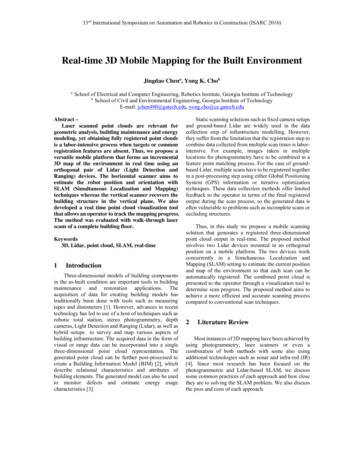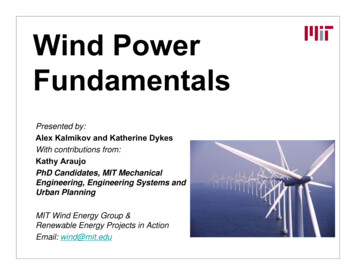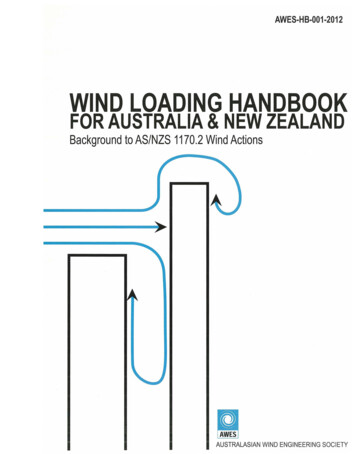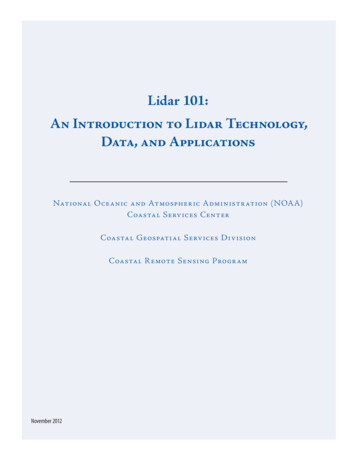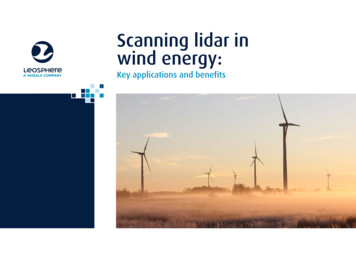
Transcription
Scanning lidar inwind energy:Key applications and benefits
When certainty is the most valuable resourceIn wind energy, millions of dollars depend ondevelopers' and operators' ability to reduce riskand establish certainty. But certainty is hard tocome by, whether it’s in wind measurement andperformance estimations, power assessments, wakeand blockage impacts, or other factors.That’s because, all too often, the available winddata is based on historical records, outputs from metmasts that likely don’t cover the whole operatingregion or rotor sweep of today’s modern turbines,and extrapolations that can introduce bias.It’s like building a puzzle withsome of the pieces missing. Youmight be able to identify thegeneral picture, but you can'tunderstand the details.In wind energy, the details are wheremoney is made and lost.MET MASTCoverage neededMet mast coverage Vaisala 2021
The arrival of scanning lidarLidar is not new to wind energy. By now, users acrossthe globe have deployed and validated thousands oflidar units — particularly vertical profilers — for variouspurposes. They have emerged as the ideal supplement(and sometimes replacement) for met masts and othertraditional wind assessment methods.But today, progressive companies — especially offshoredevelopers — are also using scanning lidar for an evenfuller, 3D understanding of the wind environment.In part, scanning lidar is a response to recent trendsin wind energy. Wind parks, particularly in Europe, arebeing built closer to each to other and are influencingeach other’s energy production. Offshore projectsare also becoming more common, complicating windresource assessment and other processes. Additionally,today’s turbines are much larger than those of even 10years ago, which brings both potential and risk. Theirperformance and bankability are becoming harderto assess.This ebook explains the principles and keyapplications of scanning lidar — and showswhy it’s becoming some companies’ newsecret weapon in the quest for certainty.MET MASTMet mast coverageWindCube Scan coverage area Vaisala 2021
How scanning lidar worksLike a vertical profile lidar, scanning lidar uses laser pulses that are sent into the atmosphere and reflectedby aerosols or particulates traveling within it. When the light is backscattered and returned to the lidar unit,the Doppler shift can be calculated, providing an accurate wind speed measurement.Unlike vertical profilers, however, scanning lidar units measure across 360 using several scanning patterns,up to ranges of 19.5km in the case of Leosphere’s WindCube Scan, which is covered in detail later.This provides 3D spatial wind awareness and, among other benefits, allows operators to assess severalturbines at once. This creates enormous efficiency, increases wind assessment certainty, and improves boththe quality and the quantity of available wind data. Vaisala 2021
Reducing spatial uncertaintyImproving certainty, decision-making,and bankabilityWind developers are familiar with using mathematical models toestimate the wind characteristics of a farm site. However, these modelsare usually based on several limiting assumptions and are missing thetrue complexity of the atmosphere, as well as complex terrain andweather effects.As a result, relying on traditional models requires some educatedguesswork on the part of the developers.Scanning lidar dramatically reduces this guesswork, allowing developersto check and refine existing wind models. Because the lidar provides somuch more localized data and less spatial uncertainty, developers canadd correction factors to their models and optimize them over time.This is especially valuable for offshore development, where wind farmsare the largest and met masts either don't exist or cannot be installed.Scanning lidar can be operated onshore while measuring offshore areas,or located on remote platforms, dramatically increasing the range anddetail of wind data.The practical outcome of this awareness is reduced vertical and spatialuncertainty. Planners can make better turbine selections (creatingfinancial and performance benefits through the life of the site) andunderstand the performance impacts of neighboring wind sites. Theycan also validate and improve other measurement outputs, improvingthe financial viability of a project.More and more offshore developers arechoosing scanning lidar to fill importantgaps in their wind data. Vaisala 2021
Case study:Case study:WindCube Scan 400S campaignWindCube Scan 400S campaignFor 6 weeks, ENGIE used a WindCube Scan 400S convenientlydeployed on the shore to measure offshore in the Southern Coast ofFrance.For 4 months, Carbon Trust and RES used several lidarmeasurements on the shore to measure offshore in the Dublin Bay.Challenge:Spatial uncertainty from mesoscale models is up to 2.5%, and everyuncertainty has a financial impact.Solution:Calibrate the mesoscale model with WindCube data.Results:Significant error from the model was detected near the coast, so acorrection factor was added.Challenge:Spatial uncertainty was a problem here as well, likely creatingnegative financial impact.Solution:Use different scanning lidar configurations to measure spatialvariation in wind resource offshore.Results:Spatial uncertainty can be reduced to 1.3% by using scanning lidars. Vaisala Vaisala2021 2020
Managing turbine and farm interactionsUnderstanding complex influencesAs today’s turbines increase in size and power, oneturbine can have a significant effect on another.Multiply those effects by the turbines on an entirefarm and the downstream consequences can belarge — even on neighboring wind farms.To address this, developers need a reliableunderstanding of wake effects and the ideal windfarm layouts. This allows them to avoid performancesacrifices within their own farm, plan expansionsmore effectively, and mitigate problematicinteractions with neighboring farms.Scanning lidar provides a real-time check of multipleturbines’ wake effects, which allows customers tooptimize design and construction. If developers andoperators do their wake assessments early, they canchoose different turbines or yaw angles to optimizethe secondary turbines’ performance.The startling costs of blockage and wakeeffectsLidar is finally helping developers and operatorsunderstand the costs of blockage and wake effects,which can rise to the millions or billions ( ) over time.Only with a solid understanding of these complexinfluences can operators protect their investments andget the most from their wind farms. Vaisala 2021
Case study:Case study:WindCube Scan 100S campaignWindCube Scan 200S campaignFor 4 months, a WindCube Scan 100S was used on the FINO1platform in Germany in order to analyze the performances of a windturbine from the Alpha Ventus wind farm.For 6 months, Goldwind used a WindCube Scan 200S to characterizethe wind field within part of a wind farm.Challenge:A significant part of the Annual Energy Production (AEP) uncertaintycomes from models.Solution:Make high-resolution measurements with a scanning lidar andcalibrate the wake models.Results:A near-wake and a far-wake model were proposed, and thescanning lidar allows operators to bridge the gap between themodels and the data observed.Challenge:AEP and wind farm layout deduced from a model can have highuncertainties.Solution:Use a scanning lidar unit to characterize the wake effect of severalwind turbines.Results:The influence of multiple wakes was analyzed, and a wind turbinewas observed to be in the wake area of another wind turbine.This identified an important AEP loss not considered in thedevelopment phase, and identified ways to improve wind farmdesign and operation. Vaisala Vaisala2021 2020
Innovating for higher performanceInnovations coming to wind energyPower curve testingWith so much flexibility and wind knowledgeprovided by scanning lidar, the industry is evolvingrapidly. Two important examples are short-termforecasting and power curve testing.Power curve testing can be burdensome fordevelopers and operators. But with scanning lidar,several turbines can be assessed at the same time— dramatically lessening the burden and providingbetter data. The lidar also provides simplifiedinstallation and operation. It is often used onshoreor on a platform for offshore measurement, sinceit can measure up to 14.7km, making it mobile andsimple to install and maintain.Short-term forecastingIn R&D studies, properly placed scanning lidar unitsreliably give operators 5–10 minutes of advancednotice if a storm or wind disruption is headedtoward the wind farm. This could benefit operatorsas well as power grid managers, potentiallyallowing them to proactively manage energyproduction and its introduction into the grid.On the operator end, this warning time might allowfor adjustments (or even shutdown) of turbinesahead of a dramatic wind or storm event. Powergrid managers, noticing a surge or drop in windfarm production, might anticipate what otherpower source might be used to compensate in theshort term.Scanning lidar provides an important baselineunderstanding of the entire turbine fleet. Over time,operators can spot-check turbines to see how wellthey are performing against estimates. One relatedbenefit is that, as OEMs start to sell performanceupgrades, operators can use their baselines to judgewhether the upgrade is worth it.For short-term measurement campaigns, a rentedscanning lidar permits customers to obtain baselinedata and then either return or reassign the lidarunits, reducing financial outlay. Vaisala 2021
Case study:Case study:WindCube Scan 100S campaignWindCube Scan 100S campaignFor 3 months, SSE used a WindCube Scan 100S on the transitionpiece of a wind turbine in the Greater Gabbard wind farm in the UKin order to make a power curve verification.For 3 months, Oldenburg University used three WindCube Scan200S units for short-termforecasting offshore.Challenge:In cases where there is no offshore met mast to do power curveverification, installing one can be very costly. A nacelle-mountedlidar also might not be an option due to wind turbine warrantyconstraints.Challenge:Grid operators require accurate and short-term forecasting ofelectricity production, and the electricity market requires highreactivity.Solution:Obtain hub-height measurements with the scanninglidar from the transition piece.Results:The power curve assessment was successful, and the studysuggested that PPT for several turbines can be performed at thesame time with just one lidar unit. The lidar data was shown to beequivalent to met mast data.Solution:Use three scanning lidar units to measure up to 6km distant andforecast near-coastal wind conditions with lead times of 5 minutes.Results:The scanning lidar units are likely to decrease uncertaintiescompared to statistical models, since any wind changes aremeasured directly and not assumed (or missed completely), aswith models. Vaisala Vaisala2021 2020
WindCube ScanLong-range wind awareness for certainty and decision-makingWindCube Scan is the industry-standard scanning lidar. It provides full 3D scanning up to14.7km and multiple scanning patterns, making it ideal for many campaign types. Built onproven, reliable WindCube technology, the system provides outstanding uptime, reliability,and user-friendly software.The system is well-suited for short-term development campaigns or long-term operations,and its rugged, industrial design withstands extreme environments. Importantly, its data iseasy to export, understand, and put to use.WindCube Scan series .5kmTypical windmeasurement rangeMaximum rangeScanner rotation speedUp to 30 /sAccumulation timeFrom 0.1s to 10sData transferEthernet/LANData formatExport in NetCDF by graphic interface or to FTP serverAPI type andfunctionalitiesREST web API; Lidar configuration and monitoring; status/activities/logsmonitoring; data download (JSON stream and NetCDF files)Available scanningstrategyAny combination of PPI, RHI, DBS and fixed beam is possible and fullyconfigurable by userWeight232kg (without options)Temperature range-30 C to 45 C (-22 to 113 F )Power consumption500W to 1.600W Vaisala 2021
Conclusion:Toward awareness and certaintyWind energy is changing. Larger turbine designs, big offshore wind farms,and plenty of other factors are disrupting the field — but there are newtools for obtaining certainty in an environment where even 0.1m/s of windspeed can amount to millions ( ) of gain or loss.WindCube units are in service around the globe with some of the world’slargest wind energy players, as well as plenty of smaller, emerging ones.They provide the rich data that developers, operators, manufacturers,service providers, and many more stakeholders need to make betterdecisions and maximize the return on their investments.Support and services you can count onWind energy isn’t just about technology. It’s about having the backingof a global partner that can directly support your business end-to-end,with complementary services, robust customer service, and consultation.Today, WindCube lidar technology is also backed by Vaisala’s 80 years ofexperience and worldwide services.Learn more about how scanning lidar can help you improve certainty,efficiency and bankability. Vaisala 2020
Why Leosphere, a Vaisala company?We are modern innovators, scientists, and discoverers who enable our customers to harness the power of wind energy in new ways. We are driven by passion,relentless curiosity, and the desire to create a better world, as evidenced in our commitment to four guiding principles:Trustworthy, superior metrologyInnovative lidars from a one-stop shopOur solutions are backed by the best science and metrology, andvalidated by the most demanding testing and certifications inthe industry. Our contributions make wind energy smarter.Customers know we have the right suite of solutions for their needsin wind energy — taking them ever higher by adding value at eachstep of the project lifecycle.Unrivaled thought leadershipEasy, reliable global solutionOur years of experience, impressive global client roster, andplethora of industry breakthroughs demonstrate that we are theiconic gold standard in wind energy.We make our clients’ lives easier. Our easy to use, turnkey WindCubeproduct suite enables customers to harness the power of windenergy efficiently and affordably.As a result, Leosphere, a Vaisala company, is the iconic and trusted gold standard in wind lidar. Our turnkey WindCube product suite offers innovative, reliable, andhighly accurate solutions for thousands of customers across the globe. All of this has enabled us to be catalysts for change and ambassadors for wind energy, alwaysadvancing the field and those we serve.Our innovation story, like the wind energy story, continues.windcubelidar.comRef. B212128EN-C Vaisala 2021This material is subject to copyright protection, with all copyrights retained by Vaisala and its individualpartners. All rights reserved. Any logos and/or product names are trademarks of Vaisala or its individualpartners. The reproduction, transfer, distribution or storage of information contained in this ebook in anyform without the prior written consent of Vaisala is strictly prohibited. All specifications — technical included— are subject to change without notice.
developers — are also using scanning lidar for an even fuller, 3D understanding of the wind environment. In part, scanning lidar is a response to recent trends in wind energy. Wind parks, particularly in Europe, are being built closer to each to other and are influencing each other's energy production. Offshore projects

